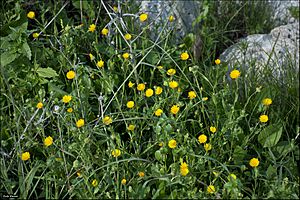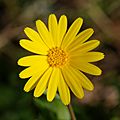Calendula facts for kids
Quick facts for kids Calendula |
|
|---|---|
 |
|
| field marigold (Calendula arvensis) | |
| Scientific classification |
|
| Kingdom: | Plantae |
| Clade: | Tracheophytes |
| Clade: | Angiosperms |
| Clade: | Eudicots |
| Clade: | Asterids |
| Order: | Asterales |
| Family: | Asteraceae |
| Subfamily: | Asteroideae |
| Supertribe: | Asterodae |
| Tribe: | Calenduleae |
| Genus: | Calendula L. |
| Species | |
|
See text |
|
Calendula is a genus of about 15–20 species of annual and perennial herbaceous plants in the daisy family Asteraceae that are often known as marigolds. They are native to southwestern Asia, western Europe, Macaronesia, and the Mediterranean. Other plants are also known as marigolds, such as corn marigold, desert marigold, marsh marigold, and plants of the genus Tagetes.
The genus name Calendula is a modern Latin diminutive of calendae, meaning "little calendar", "little clock" or possibly "little weather-glass". The common name "marigold" refers to the Virgin Mary. The most commonly cultivated and used member of the genus is Calendula officinalis, the pot marigold. Popular herbal and cosmetic products named "Calendula" invariably derive from C. officinalis.
Calendula is one of the two birth flowers for the month of October, the other being Cosmos.
Uses
History
Calendula was not a major medicinal herb but it was used in historic times for headaches, red eye, fever and toothaches. As late as the 17th century Nicholas Culpeper claimed Calendula benefited the heart, but it wasn't considered an especially efficacious medicine.
In historic times Calendula was more often used for magical purposes than medicinal ones. One 16th-century potion containing Calendula claimed to reveal fairies. An unmarried woman with two suitors would take a blend of powdered Calendula, marjoram, wormwood and thyme simmered in honey and white wine used as an ointment in a ritual to reveal her true match.
Romans and Greeks used the golden Calendula in many rituals and ceremonies, sometimes wearing crowns or garlands made from the flowers. One of its nicknames is "Mary's Gold," referring to the flowers' use in early Catholic events in some countries. Calendula flowers are sacred flowers in India and have been used to decorate the statues of Hindu deities since early times.
However, the most common use in historic times was culinary, and the plant was used for both its color and its flavor. They were used for dumplings, wine, oatmeal and puddings. In English cuisine Calendula were often cooked in the same pot with spinach, or used to flavor stewed birds. According to sixteenth-century Englishman John Gerard, every proper soup of Dutch cuisine in his era would include Calendula petals.
Culinary
The petals are edible and can be used fresh in salads or dried and used to color cheese or as a substitute for saffron. It can be used to add color to soups, stews, poultry dishes, custards and liquors.
The common name for Calendula officinalis in Britain is 'pot-marigold,' named so because of its use in broths and soups.
Dyes
Dye can be extracted from the flower and produce shades of honey, gold oranges, light browns, and vibrant yellows.
Chemistry
The flowers of C. officinalis contain flavonol glycosides, triterpene oligoglycosides, oleanane-type triterpene glycosides, saponins, and a sesquiterpene glucoside.
Pharmacological effects
Calendula officinalis oil is still used medicinally is use as an anti-inflammatory and a remedy for healing wounds. Calendula ointments are skin products available for use on minor cuts, burns, and skin irritation; however, evidence of their effectiveness is weak.
Plant pharmacological studies have suggested that Calendula extracts have antiviral, antigenotoxic, and anti-inflammatory properties in vitro. In herbalism, Calendula in suspension or in tincture is used topically for treating acne, reducing inflammation, controlling bleeding, and soothing irritated tissue. Limited evidence indicates Calendula cream or ointment is effective in treating radiation dermatitis. Topical application of C. officinalis ointment has helped to prevent dermatitis and pain; thus reducing the incidence rate of skipped radiation treatments in randomized trials.
Calendula has been used traditionally for abdominal cramps and constipation. In experiments with rabbit jejunum, the aqueous-ethanol extract of C. officinalis flowers was shown to have both spasmolytic and spasmogenic effects, thus providing a scientific rationale for this traditional use. An aqueous extract of C. officinalis obtained by a novel extraction method has demonstrated antitumor (cytotoxic) activity and immunomodulatory properties (lymphocyte activation) in vitro, as well as antitumor activity in mice.
Calendula plants are known to cause allergic reactions, and should be avoided during pregnancy.
Diversity
Species include:
- Calendula arvensis (Vaill.) L. – field marigold, wild marigold
- Calendula denticulata Schousb. ex Willd.
- Calendula eckerleinii Ohle
- Calendula incana Willd.
- Calendula incana subsp. algarbiensis (Boiss.) Ohle
- Calendula incana subsp. maderensis (DC.) Ohle – Madeiran marigold
- Calendula incana subsp. maritima (Guss.) Ohle – sea marigold
- Calendula incana subsp. microphylla (Lange) Ohle
- Calendula lanzae Maire
- Calendula maritima Guss. - sea marigold
- Calendula maroccana (Ball) Ball
- Calendula maroccana subsp. maroccana
- Calendula maroccana subsp. murbeckii (Lanza) Ohle
- Calendula meuselii Ohle
- Calendula officinalis L. – pot marigold, garden marigold, ruddles, Scottish marigold
- Calendula palaestina Boiss.
- Calendula stellata Cav.
- Calendula suffruticosa Vahl
- Calendula suffruticosa subsp. balansae (Boiss. & Reut.) Ohle
- Calendula suffruticosa subsp. boissieri Lanza
- Calendula suffruticosa subsp. fulgida (Raf.) Guadagno
- Calendula suffruticosa subsp. lusitanica (Boiss.) Ohle
- Calendula suffruticosa subsp. maritima (Guss.) Meikle
- Calendula suffruticosa subsp. monardii (Boiss. & Reut.) Ohle
- Calendula suffruticosa subsp. tomentosa Murb.
- Calendula tripterocarpa Rupr.
Gallery
See also
 In Spanish: Caléndulas para niños
In Spanish: Caléndulas para niños










